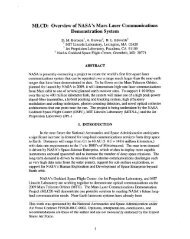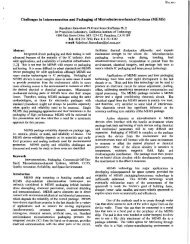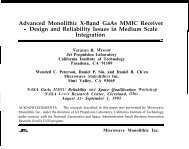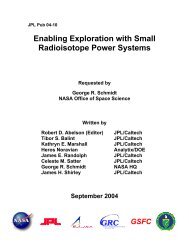f - NASA Jet Propulsion Laboratory Technical Reports Server
f - NASA Jet Propulsion Laboratory Technical Reports Server
f - NASA Jet Propulsion Laboratory Technical Reports Server
Create successful ePaper yourself
Turn your PDF publications into a flip-book with our unique Google optimized e-Paper software.
Phase 3: This is the final phase using the RC helicopter and at the completion of this test the system should be ready for<br />
the real VTV traveling at speeds of 70 MPH. During this series of tests the aircraft and the VTV are both in the air. The<br />
VTV is performing a circular pattern out in the range and the aircraft is hovering at an altitude between 200-400 feet.<br />
Phase 1 started in November 1997 at NTPS, Mojave, CA. VIGIL was integrated into the Ultrasport. Testing proved the<br />
attitude-GPS to be too inconsistent and affected by multi-path or change of satellite constellations. During these tests the<br />
tracking algorithm utilized the VTV position data and the aircraft attitude and position data for tracking the RC helicopter.<br />
Preliminary tests of an IMU based tracking was performed, and an IMU algorithm as begun to eliminate the vagaries of the<br />
GPS-based attitude solution.<br />
HARDWARE CONFIGURATION OF PHASE 1 TESTING:<br />
VTV Position data: Data at 10 Hz used for tracking<br />
IMU data: Data at 1 OOHz used for preliminary tracking tests<br />
ATTGPS data (aircraft position and attitude): Data at 10 Hz used for tracking.<br />
Air platform:<br />
VIGILANTE Ultrasport 496<br />
Gimbal Position data: Data provided upon command.<br />
Main Algorithm Tracking loop: Operating at 3 Hz.<br />
IMU/Attitude tracking solution: Not implemented yet.<br />
Between November 97 and January 98 system upgrades were implemented to insure the system accuracy and stability. For<br />
example the upper GPS antennas on the aircraft were moved further away from the main rotor hub. Status bits were<br />
incorporated into all the GPS data to provide better visibility into the state of the hardware. The IMU was characterized<br />
over long periods of time to establish an understanding all the drift rates.<br />
Experiment 1 resumed at NTPS this February continuing on Phase 1 and proceeding to phases 2 and 3. During these tests<br />
the IMU data was integrated into the tracking loop and used with the attitude data of the aircraft. The air platform was<br />
temporarily changed from the Ultrasport 496 to a Hughes 500 pending flight envelope tests on the Ultrasport. The<br />
hardware configuration for the final phase 1-3 is listed below along with Figure 10 and 11 showing digitized images of<br />
tracking video for phase 2 and 3 respectively. Both phase 2 and 3 the VTV was approximately 830 m away and in phase 3<br />
the Hughes 500 was approximately hovering at 30 m.



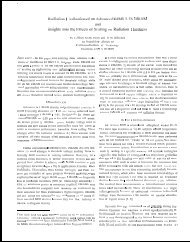


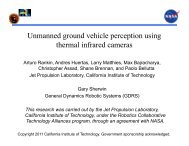



![Ana]ysis of Reaction Products and Conversion Time in the Pyrolysis ...](https://img.yumpu.com/11715548/1/190x242/anaysis-of-reaction-products-and-conversion-time-in-the-pyrolysis-.jpg?quality=85)
